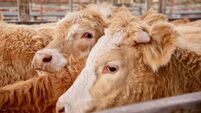Ghosts of the past in farms of the present
My reason for calling was to collect payment for a few hundred small square bales of straw Jim had collected from me at harvest time.
While he had given me directions, I’d never been to his place, and I found myself reflecting on how little I really knew of my local area, as I turned in the narrow road that I had passed thousands of times previously.
After a time, the council chippings ended and gave way to the hardcore underlay as the road began to edge upwards. The hedges were nicely trimmed but the lane itself was uneven with occasional potholes and culverts cut by running water. Tipped loads of mill waste and chippings by its side gave testament to the on-going maintenance battle between its owner and the elements.
Laneway negotiated, I next edged the car to one side as I navigated the centre stone between two strongly built stone piers, before coming to a stop in a sloping yard.
In front of me was a large two-storey farmhouse which, like the gates at its entrance, was probably at least 100 years old.
The outbuildings were of a similar age or maybe older, whitewashed with smart sheeted gates hanging perfectly under their red- brick arches. On one side of the yard, however, was a long, low building with a tumbled down chimney and sheets of zinc covering the door and windows.
The house at the top of the yard was formerly the family home, but is now Jim’s mother’s residence. A medium-sized and agile lady with a broad smile, she tells me Jim is probably down at his own house, “getting dinner ready, if he’s not tinkering in his work shop”. Jim’s wife works as a secondary school secretary.
As I walk down the yard, Jim comes up smartly to greet me. “You found us, and welcome,” he says, extending a strong arm. We shake and chat about the weather and farming prospects.
After a time, I mention the long low house with the broken chimney. Walking down the yard and out the gate, Jim points to a series of farm buildings, some collapsed, that face the other side of this long house. He explains that prior to the famine of the 1840s, both his yard and this had been one, with the main residence right down the middle, “front and back yards”, he says.
There followed a fascinating story of how, with the local landlord demanding ever higher rents, and with the two sons deciding to seek their fortunes in America, it fell to the two daughters to marry men to work the place. In time, new children arrived to one couple, but not to the other. With strong sons and daughters, Jim’s ancestors “held tough with land”, while the second couple passed it to the wife’s husband’s people.
“Surely the sister with no family would have considered uniting it all again,” I say. Jim smiles, “Yes, she might, but when she died, the husband got it, and in his turn, he gave it to his relations.”
“What about the brothers in America?” I ask.
He shakes his head: “I don’t even know if they knew. It was an awful long time ago.”
Indeed it was, and over the years, half of the farm became an out-farm for one branch of the family, so that now, the once fine dwelling house is a cattle shed, with a round feeder outside its front door.
Life and history live side by side in country areas, but seldom so vividly; or so I thought. My next visit on my round of collections was to a farmer whose family history has left him with a collection of religious memorabilia from penal times!









